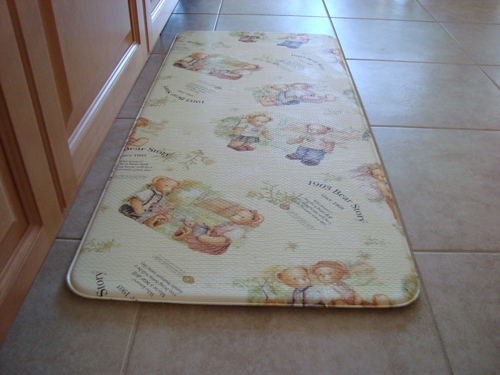You are here
Anti-Fatigue Mats for Healthy Joints and Soft Tissues
Comfortable and supportive shoes or sandals can go a long way in protecting your feet, ankles, knees, hips, and spine from injury.
When you're without footwear and working indoors on hard flooring, I encourage you to consider using an anti-fatigue mat to provide all of your major weight-bearing joints with cushioned support. Here's one that we have by our kitchen sink:
Anti-fatigue mats can be immensely helpful in preventing joint and soft tissue problems. I've found that people with degenerative arthritis in the knees and hips tend to notice an immediate ease in discomfort when they start using a cushioned mat while doing the dishes or cooking by a counter or stove top. Ditto for plantar fascitis.
Though anti-fatigue mats are most commonly used in the kitchen, I consider them a must for anyone who has to stand in one place for long stretches of time. If your job requires constant standing, I encourage you to get an anti-fatigue mat or ask your employer to consider providing one to help keep you and other team members healthy.
If you're going to invest in a mat for your kitchen, be sure to get one that is waterproof, easy to clean, and that has at least half an inch of dense foam padding.
We picked ours up at a Korean market just north of Toronto. But anti-fatigue mats are widely available through most department and hardware stores. Here are a few high quality anti-fatigue mats that are available through Amazon:
Sublime Imprint Anti-Fatigue Nantucket Series
WellnessMats Anti Fatigue Mat - Burgundy
Along the same line of thought, if you have area rugs in your home and you feel that your joints can use extra support, an easy and relatively inexpensive solution is to pick up some dense foam underpad from a local carpet shop. Just measure out your area rugs, order your underpad a good inch or two smaller on all sides, then slip it under your rugs.
Be sure to get the highest grade underpad you can afford. There isn't much difference in cost per square foot between high and medium grade underpads. And your joints will really feel a difference with the good stuff. Plus, high grade underpad will last longer and make your area rugs feel new. Please remember this if you ever put in new carpet - don't skimp on the underpad! Not only will it help keep your joints healthy, good underpad will also lengthen the life of your carpet.
Hope this information proves to be useful to your body.
Join more than 80,000 readers worldwide who receive Dr. Ben Kim's free newsletter
Receive simple suggestions to measurably improve your health and mobility, plus alerts on specials and giveaways at our catalogue
Please Rate This
Highest Rated | Related Posts | ||












Comments
Anti Fatigue Floor Mats
Hi Dr Kim,
Thank you for such a wonderful newsletter and all you do to inpower ones with the free will of choice regarding their health.
I enjoyed this article as well as your other articles and recipes and recommendations.
Along with using this anti fatigue mats, what are your thoughts on ones raising their feet above the heart as a form of 'exercise'?
I appreciate you,
Julia
weight-bearing exercise?
Thanks for this informative article! On a related note, would you agree that a moderate amount of weight-bearing exercise is good for you? If so, wouldn't a moderate amount of walking barefoot on a hard floor be good for you? (Or am I confusing things?) Arthritis runs in my family, hence my particular interest.
Hi Moorea,
Hi Moorea,
Yes, I think a moderate amount of weight-bearing exercise can be helpful to our health, as can a moderate amount of walking barefoot on solid floors.
With that said, I feel that each person's circumstances should be taken into account. For example, both of the statements above definitely hold true for someone who is relatively fit and healthy. But for someone who has some degree of osteoporosis in their spine or a metabolic arthritis like rheumatoid in their feet, it would be better to avoid stressing the spine and feet, respectively.
There may be a genetic predisposition for developing osteoarthritis or rheumatoid arthritis in your family, but I find it encouraging to know that genetic predispositions can be avoided where our daily choices don't trigger them. Your diet and lifestyle being quite healthy relative to the masses, my guess is that as long as you don't regularly engage in activities that are traumatic to your joints, you will not develop any type of arthritis in your body. I hope these thoughts are helpful!
Ben